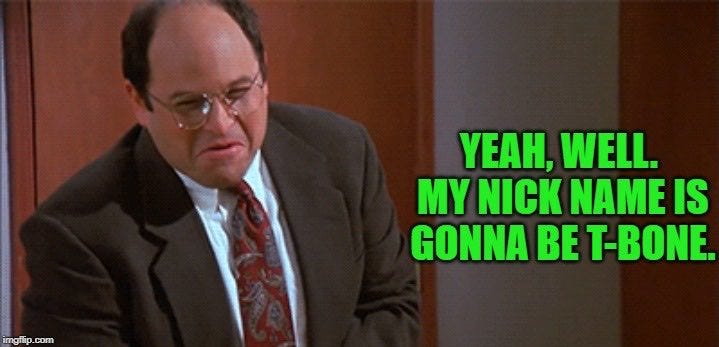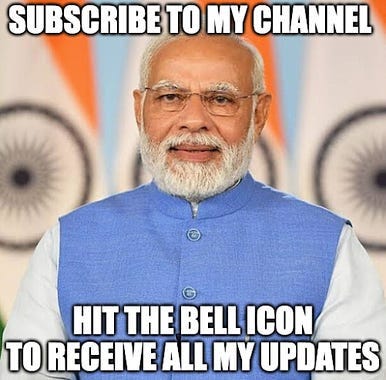The super-app hiding in plain sight
As social media morphs into entertainment, YouTube increasingly stands out from the crowd
I've had a few nicknames over the years, but none has stuck - just like George Costanza's attempt to be known as "T-Bone" in Seinfeld's The Maid episode. Sparky was an early one for me, but only a small group used it. My good friends Rich Rust (Hi Rich!) and Rupert gave me a few during our time together at immediate future: Wainwrong, Wangers, Wang-lord. My brother is Wainy to most people - mainly, I'm just Mark.
While I'm not sure why my nicknames didn't become universal, I know what George's problem was. You can't give yourself a nickname. Someone must bestow it on you. It springs up from the ether unnoticed and sticks around with little comment and scant explanation. "Oh, your real name is Richard; so why does everyone call you Bob?" Well, it's a long story…
And just like you can't give yourself a nickname, it's pretty much impossible to "build" a super-app. Sorry, Elon - Twitter as the Everything app isn't going to happen; you're the T-Bone of tech.
We had a similar conversation with a client at Teneo a few years ago. They wanted us to help them make a super-app from their existing services. Our counsel was it doesn't work like that. You need to start with one thing and then slowly build and iterate out from there - until your app is so valuable and inescapable people start calling it a super-app. Then, like every grunge and Britpop band, you can say, "Oh, we don't like the label 'super-app', but if other people want to use it, that's up to them," and bask in your world-conquering glory.
Facebook tried to become a super-app back in the day, trying to copy the WeChat model with bots that could replace the apps on your phone. It didn't work out - the whole Cambridge Analytica thing and all that.
TikTok is doing it now with its aggressive shopping push and adding YouTube-style horizontal videos. As this piece in Gizmodo argues, it might work out. But the super-app paradox is tricky to navigate - the more features and services you add to do everything, the more you risk compromising the reason people loved your platform in the first place.
Both TikTok and Facebook see the success and ubiquity of WeChat in China and aspire to achieve something similar in the rest of the world. But maybe they're looking in the wrong place for a super-app success story to emulate. Maybe there's one app that's already so ubiquitous, so intrinsic to our lives, that it's already achieved Twitter's "Everything" vision.
I'm talking about YouTube. The size and popularity of YouTube featured heavily in my email subscriptions over the past couple of weeks. Eight million subscribers to YouTube TV in the US. One hundred million YouTube Premium and Music subscribers, generating $15 billion in revenue for parent company Alphabet.
I was sceptical of the whole Shorts/diet TikTok push, but the aggressive marketing in-app works, with the format racking up the views. Most noticeably, YouTube has successfully integrated Shorts without suffering an Instagram-style backlash. The core YouTube product remains strong, growing to the point that one billion hours of YouTube are watched on people's TVs every day (by comparison, Netflix users watch around 203 million hours per day). As Adam Bumas puts it in Garbage Day, the distinction between small-screen and big-screen videos has disappeared - just use YouTube for everything.
But numbers are just numbers - good for articles like these and earnings reports, meaningless in isolation. It's also important to look at a platform's cultural clout. Facebook has been the biggest platform in the world for a long time now; it's also been a cultural wasteland for a long time. Threads may be prevalent in terms of numbers, but it's not a creator/internet drama hotspot. YouTube remains one of the pre-eminent creator havens, covering almost everything except the adult market cornered by OnlyFans.
And what marks YouTube out as a super-app isn't just its numbers or creators; it's the myriad of different ways people use it. The third-party data analysis I referenced a few weeks ago found that most views for the most prominent channels come via algorithmic home page recommendations. The in-depth study "found little correlation between subscribers and views", leading them to suggest that YouTube recommendations "are the primary drivers of traffic on the site".
In other words, YouTube is primarily an entertainment hub. People visit the site or open the app to find something to watch, in much the same way they use Netflix or used to watch linear TV.
YouTube is also one of the world's most prominent search engines - handy for anyone looking for advice on completing a task they've not done before. In the early stages of my gardening leave, when I was more productive lol, I successfully changed a radiator valve using just YouTube videos. If you need an answer, YouTube has it.
It's also one of the world's most popular music streaming services - and, increasingly, a content repository for people as well as brands. The researchers I mentioned call this "Deep YouTube": "an archive for friends and family, a public record, a tertiary channel for some other type of media". Add Shorts into the mix, alongside Twitch-like gaming functionality and the ability to make money as a creator, and YouTube has something for everyone.
It's the closest thing to a super-app here in the West. Sure, it's not the everything app that WeChat is (or was) for China, but when it comes to entertainment and "content", it does it all.
It's clear the advertising industry already sees this - on those occasions I watch YouTube on my TV (i.e. without an adblocker), it feels like watching any other ad-supported broadcast medium, with 20-30 second unskippable ads increasingly prevalent alongside shorter, more YouTube-y spots.
For comms agencies and social media teams, YouTube has always been a different beast to the likes of Instagram, LinkedIn and Twitter. Building an owned channel presence requires long-term investment and thinking "entertainment-first" instead of campaign or message first.
But clearly, there are opportunities on the platform, depending on which aspect you tap into. The aforementioned broadcast-style brand-building advertising approach. Creating search-driven hygiene videos that help your target audience answer specific questions about your brand or business.
Or going down the influencer partnership route to tap into creators' experience navigating YouTube's algorithm(s). None of these approaches require you to become a publisher and build your own channel, as might have been the case in the mid-2010s. Before I left Teneo, we'd started helping a major pharmaceutical brand take its first steps into keyword-driven video advertising. It doesn't just have to be for the Nikes or Unilevers of this world.
And it's not just brands and businesses planning to take advantage of YouTube's status as a super-app with extensive influence and reach. In India, political advertising budgets are increasingly directed towards YouTube, as this excellent piece Rest of World highlights. Prime Minister Modi wants you to "like and subscribe" just like any other influencer. If political parties in the UK and the US follow suit this year, 2024 could be the first of a series of YouTube elections. The super-app may well play a key role in defining the political landscape of the next few years.
You can bet that the execs at YouTube and Alphabet won't rush to call YouTube a super-app themselves, however; doing so may invite further regulatory scrutiny. It's a term that screams monopolistic control, after all.
And like my various short-lived nicknames over the years, the definition of YouTube as a super-app isn't that likely to stick. YouTube will stay simply YouTube. But its size, prevalence, ubiquity, and cultural clout are unlikely to disappear overnight. So maybe we should all be looking to prioritise it a little more in our campaigns over the next few months.



